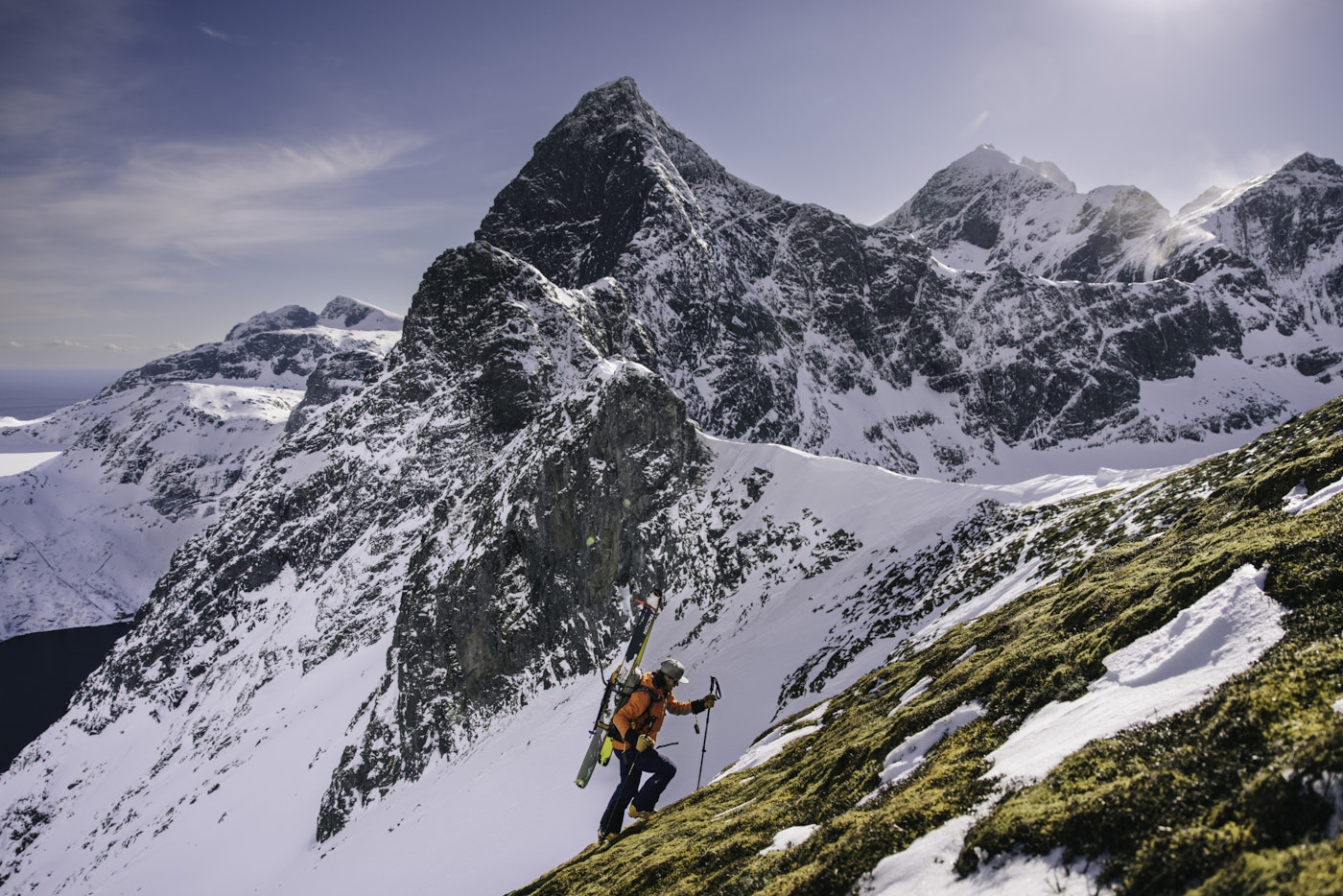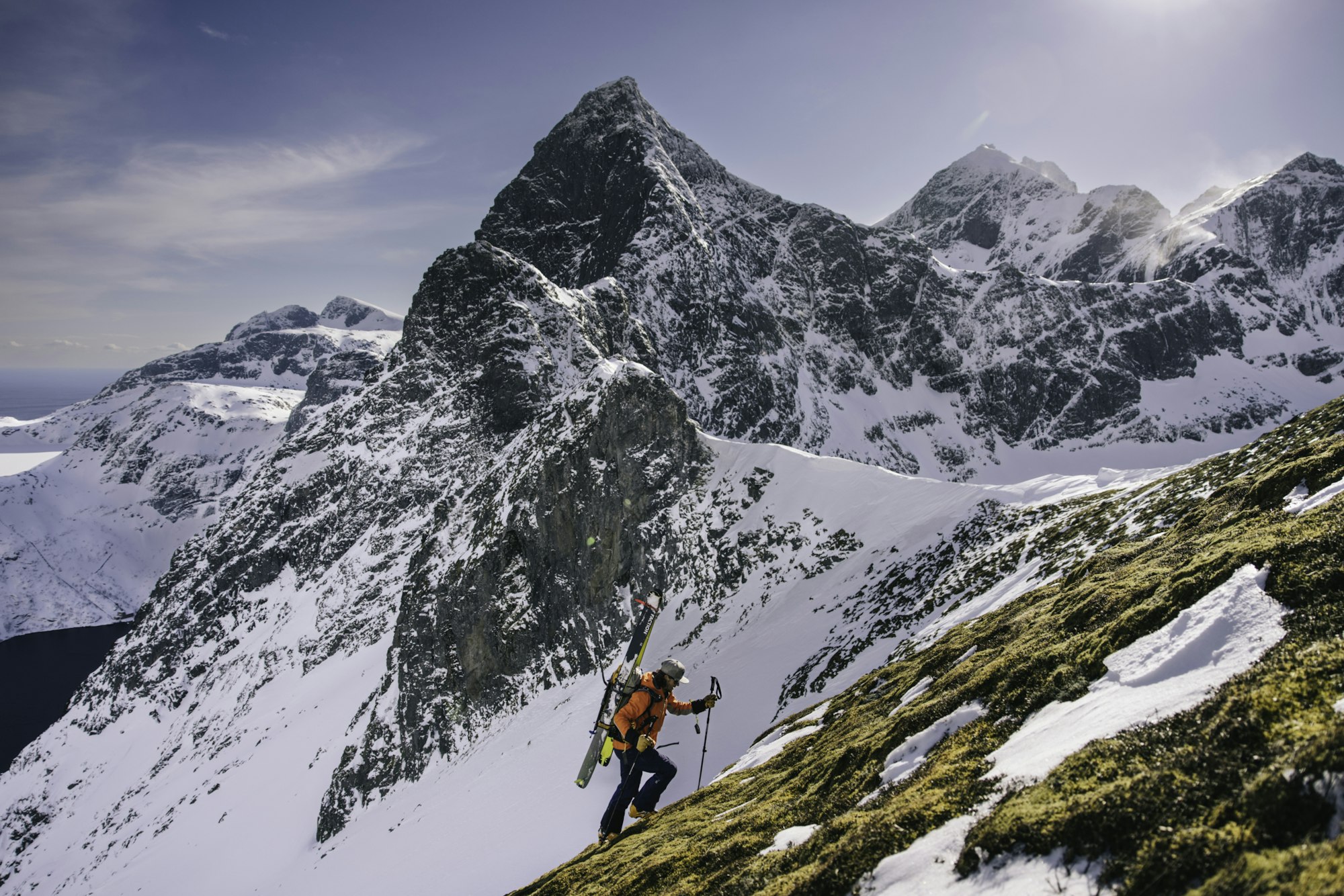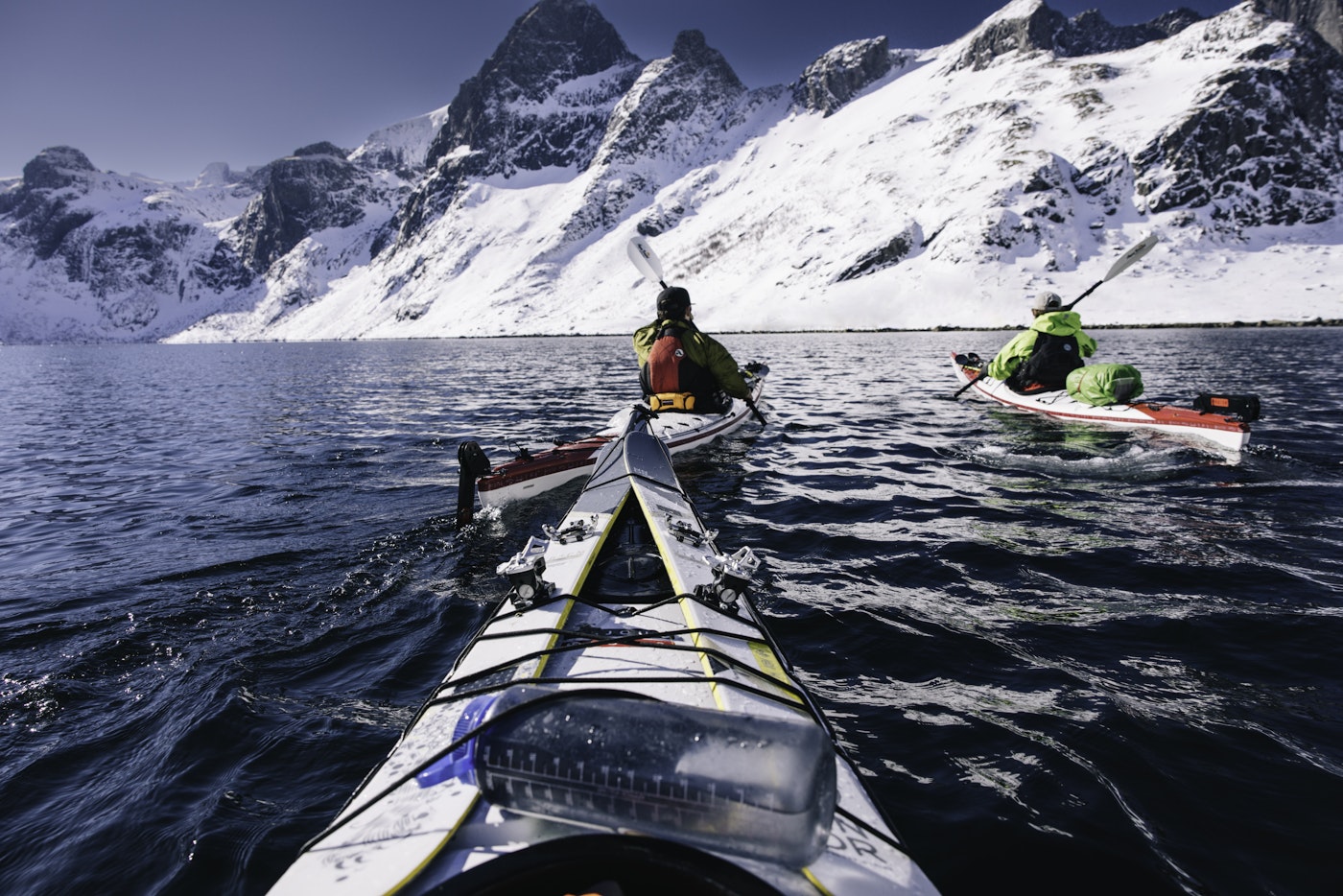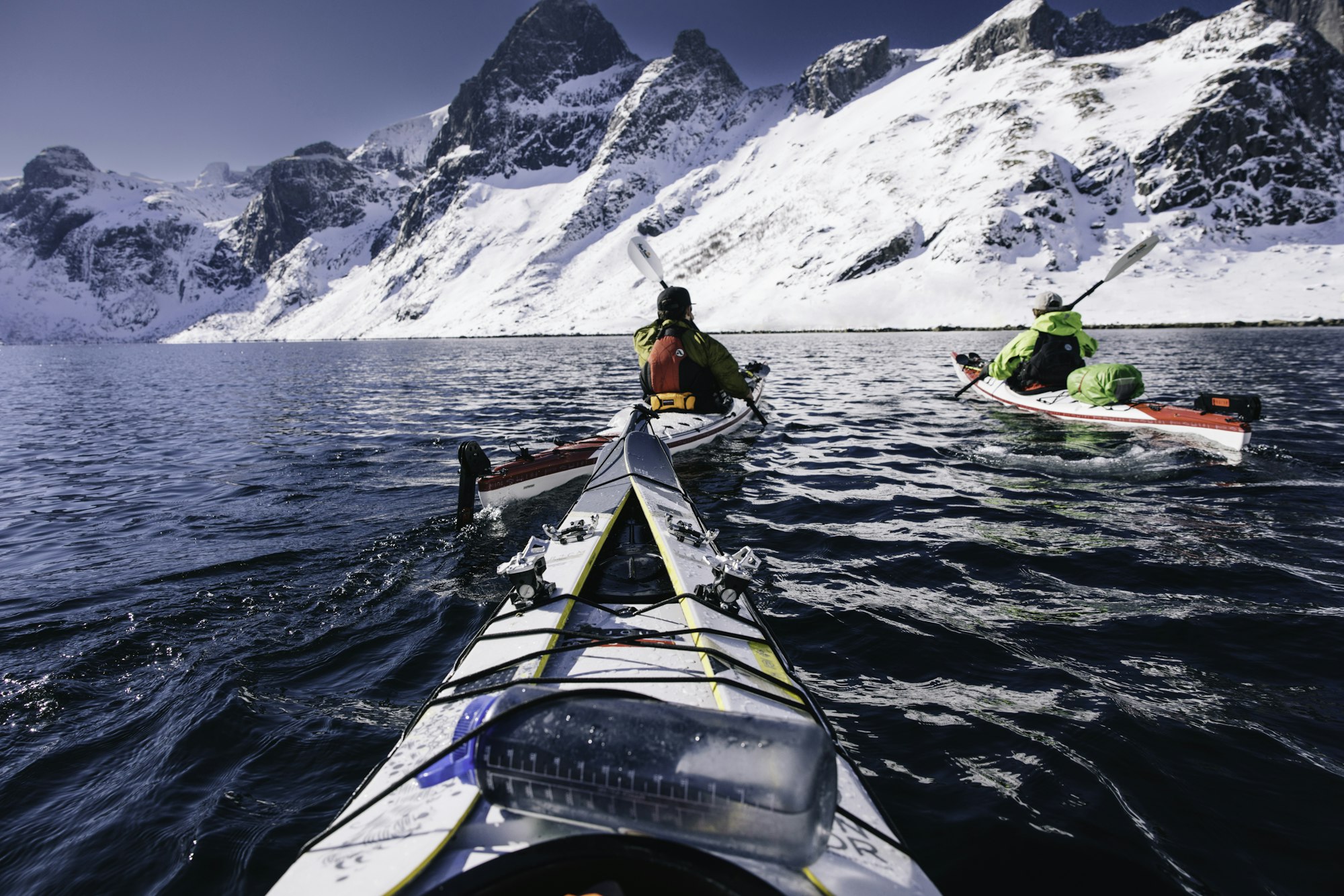Featured Image: Andy Cochrane | Skier: Matt Chorney | Location: Reine, Lofoten
It’d be a stretch to call me devout, unless the chapel in question is planet Earth. I worship no almighty deity on any given Sunday, well, other than an accurate avalanche forecast. I’ve never been baptized, well, unless a shot-ski or tailgate beer counts. I pray sometimes, but only for self-absorbed outcomes like fresh tracks and double burrito lunches. If this makes me a blasphemous heathen, so be it.
Instead of cash, I pay tithes in frozen fingers and sleepless nights in nylon bivvys. I see proselytizing as immoral, with the exception of converting knuckle-draggers to two-plankers. When I sin–like missing a powder day–I repent by picking up more hitchhikers. I believe that salvation, if there is such a thing, is more likely found in a Snickers bar than a preacher’s sermon. God must understand.
These aren’t ephemeral thoughts, either. I’ve seen them, felt them, lived them, and learned them from a place that doesn’t care for bullshit. The mountains are honest. There’s no room for ego, dollar bills or debts owed. When you’re in the trenches against snow demigods, there is no debate about fate versus free will. You just do the damn thing.
Stuck In A Storm
Hunkered in our dome tent, listening to the winds whip outside, we made half-jokes about the kayaks being blown away. The tent was staked like concrete with paddles and poles, but the kayaks were just burrowed in the snow, a dozen or so feet from shore. We hoped the gear still inside the hatches was enough weight to keep them grounded. As much as I love a plot twist, I wasn’t in love with the idea of being stranded on this uninhabited beach in northern Norway.
At the moment it didn’t feel like a predicament, mostly because we had little say in the matter. We’d hastily finished cooking dinner as the storm rolled in, diving into the tent with our half-hydrated meals before a wall of rain and snow encroached our campsite. Sitting in my sleeping bag still wearing my ski shells, I had no plans to leave the tent in these winds–not even to pee.
On just our first night of this novel kayak-to-ski mission and the plan was eroding, quickly. After strapping skis to our fiberglass ocean-faring boats and paddling across miles of exposed water, our aim was to knock off a few lines on the northwestern tip of Lofoten–a road-less area that’s impossible to access without a boat. However, the high seas had forced us into a new area, a protected bay we knew little about. No man’s land, so to speak.
Locals told us this type of fickle weather was commonplace, especially in the spring. Temps hover around freezing, making precipitation a mix of rain, sleet and snow at any given hour. Generally miserable conditions for both boating and skiing, unless you get lucky. We planned for the worst, packing spare layers, extra food and double the whiskey, but it’s one thing to plan for it and another to experience it in real life.
Forgiveness For Our Sins
Like most sinners, we knew what we had done wrong, but we refused to admit it. There wasn’t a nearby priest to repent to, anyway. Committed to the idea and collectively stubborn enough to believe it would work out, we sat in the tent, eating Thai Curry in silence.
Two degrees north of the Arctic Circle and miles from the closest town, waiting was the only option. I’m generally a cup-half-full type of guy, but my overly optimistic attitude sometimes gets me into trouble. This was a good example.
I started digging through maps to see if there was decent ski terrain nearby, but Wyatt was focused on more pressing questions, “Ever pooped in a vestibule?” he asked, stone-faced. I laughed, appreciating his comedic relief, but after a few seconds, I realized he was serious. And, no, I hadn’t.
In the Arctic, with no trees to protect you from the wind and no humans (other than us) stupid enough to camp this time of year, we had to solve our own problems. Even the basic, bodily ones. That’s when I started to pray for better weather, so we could ski.
Fortune Favors The Bold
Even a matrix of tie-downs won’t fully stop a tent from whipping in the wind. At dawn, the storm finally broke, giving us a couple hours of sleep. When we woke, groggy and disheveled, we realized how still it was outside the tent. Not even the sound of a crashing wave. True serenity in a faraway place.
We crawled out of our bags and through the front tent door, ready for a cup of instant coffee. We knew a lot of the terrain near camp would be wind scoured and loaded, but we hoped a few good turns were still out there, if we searched in the right places. Worst case, we would get some exercise and have a story to tell. Following a hot breakfast, we started skinning up the valley towards a large col that offered a variety of slopes and aspects.
Local ski guides rarely go this far down the Lofoten archipelago, sticking to more accessible zones. That was the draw for this trip–using kayaks to establish new routes–but it also was the big risk. We didn’t have beta on the area, in guidebooks or otherwise. Just our best judgment, Gaia Maps and trust in each other. It was a true adventure.
Better Lucky Than Good
Whether it was the odds finally breaking in our favor or some Norwegian God taking mercy on us, I don’t know. Either way, we made steady work of the ascent, stopping periodically to dig pits to assess the stability. Conditions were better than we expected– wind affected on ridges, but otherwise right-side-up with no signs of cracking or connectivity in the new layer.
Coincidentally, it was Sunday, and we were ski touring in the most fundamental cathedral. We didn’t need stained glass windows and large altars to know our path in life. The wind and snow kept us humble. This was our communion, shuffling legs and arms, moving ourselves uphill. Soon enough we would be born again, using gravity with all of God’s glory.
In my head I listed the few commandments I could recall, totaling just three. No stealing, no killing, and the sanctity of God’s holy day. If there is a heaven, it’s probably a perfect slope with unlimited refills. After a few laps, we headed back to the boats, to begin the journey home. Our ski-to-time ratio was, by all measures, terrible. A few dozen minutes of good turns for days of adventure, but that wasn’t the original goal. We wanted to test ourselves by doing something totally new, and that was a clear success.
How to Get There
The easiest way to get to Lofoten is to fly to Oslo, then take a smaller, domestic flight north. The two best airports are Harstad/Narvik (EVE) at the western end of the archipelago, and Svolvær (SVJ) which is roughly in the middle). Some opt to fly to Leknes (LKN) as well. From any of these you will also want to rent a car, to get to various backcountry ski destinations in the area.


PHOTO: Andy Cochrane
Where to Stay
There are plenty of Airbnbs and hotels in Lofoten, primarily clustered in small towns like Ballstad, Reine, Svolvær, Leknes and others. My favorite basecamp before or after a big ski trip in Lofoten is Hattvika Lodge, located in Ballstad. The owner, Kristian, is one of the most friendly and helpful people you can meet. He’s also an avid skier, and has pointed me to more than a few hidden gems in the area.
Oslo
A day in Oslo is a worthwhile stopover, with plenty of sightseeing options like the Viking Ship Museum, Norse Folk museum, a bounty of delicious food options and a mandatory stop at a floating sauna to relax after a big ski trip.
Insider Tips From the Author
Pro tip #1: Watch the weather–but never trust what the weatherman says. Due to its proximity to the North Atlantic, Lofoten has fast-moving and fickle weather. Even on short, half-day tours, be prepared for anything.
Pro tip #2: Beware of sharks—on the mountain. Due to lower elevations, the depth of the snowpack changes dramatically from the top of a run to the bottom.
Pro tip: #3: The best time to visit is early March through late April. Lofoten is entirely within the Arctic Circle, meaning that in January and most of February, there is little to no daylight at all. Temps near the ocean stay fairly consistent, often mid 20s to mid 30s.


PHOTO: Andy Cochrane
Stats
Elevation: The highest point in Lofoten is Himmeltindan, at 3,100 feet. It’s a great peak to ski, with multiple descent options. Many peaks in the area have a prominence of 2,500 feet (or more) above sea level.
Avg. annual snowfall: 180” (But like I said, don’t trust the forecast.)
Vertical drop: On most years you can ski all the way down to the ocean (or close to it), meaning the longest runs are sometimes 3,000 feet; more typically, 2,000. On a good day, we would complete multiple laps, often skiing a new line each time.
![[Destination] A kayak-to-ski mission into the heart of Norway’s fjords](https://www.datocms-assets.com/163516/1751469926-andycochrane-8126.jpg?auto=format&bg=FFFFFF&w=100)
![[Destination] A kayak-to-ski mission into the heart of Norway’s fjords](https://www.datocms-assets.com/163516/1751469926-andycochrane-8126.jpg?auto=format&bg=FFFFFF&w=1200)

![[GIVEAWAY] Win a Head-to-Toe Ski Setup from IFSA](https://www.datocms-assets.com/163516/1765920344-ifsa.jpg?w=200&h=200&fit=crop)


![[GIVEAWAY] Win a Legendary Ski Trip with Icelantic's Road to the Rocks](https://www.datocms-assets.com/163516/1765233064-r2r26_freeskier_leaderboard1.jpg?auto=format&w=400&h=300&fit=crop&crop=faces,entropy)




![[GIVEAWAY] Win a Head-to-Toe Ski Setup from IFSA](https://www.datocms-assets.com/163516/1765920344-ifsa.jpg?auto=format&w=400&h=300&fit=crop&crop=faces,entropy)


![[Destination] A kayak-to-ski mission into the heart of Norway’s fjords](https://www.datocms-assets.com/163516/1751469926-andycochrane-8126.jpg?auto=format&bg=FFFFFF&w=2000)